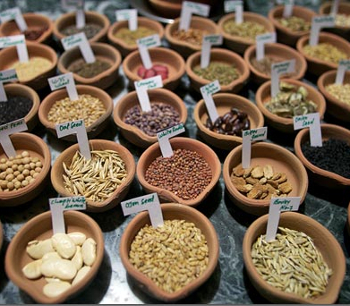Saving Seeds the Right Way Can Save the World's Plants

For decades, these seed collections have been guided by simple models that offer a one-size-fits-all approach for how many seeds to gather, such as recommending saving 50 seed samples regardless of species' pollination mode, growth habitat and population size.
A new study, however, has found that more careful tailoring of seed collections to specific species and situations is critical to preserving plant diversity. Once seeds are saved, they can be reintroduced for planting in suitable locations if conditions are favorable.
In the study, researchers from the National Institute for Mathematical and Biological Synthesis and the University of Tennessee used a novel approach called simulation-based planning to make several new sampling recommendations, confirming that a uniform approach to seed sampling is ineffective.
First, collectors must choose their plant populations from a wide area rather than a restricted one. Sampling widely can capture up to nearly 200 percent more rare genes than restricted sampling. In addition, in most situations, collecting from about 25 maternal plants per population versus 50 plants appears to capture the vast majority of genetic variation. The study also showed that for many species, collecting more than eight to ten seeds per plant leads to high overlap in genetic diversity and would thus be an excess of effort.
Increasing concerns over agriculture and food security as well as an increasing recognition of how fast biodiversity is disappearing has prompted seed banks to ramp up their collections. By the same token, botanic gardens that were once more focused on showcasing plants are now increasingly having a conservation mission too, according to the study's lead author Sean Hoban, a postdoctoral fellow at NIMBioS.
“Our approach can be used to further refine seed collection guidelines, which could lead to much more efficient and effective collections, allowing us to preserve more diversity of the world's plants. These collections could benefit future ecosystem restoration projects as well as improve agricultural and forestry efforts,” Hoban said.
Hoban and his colleagues are now working on ways to custom-tailor seed collections to particular species' dispersal, mating system and biology.
The study was published in the journal Biological Conservation.
Citation: Hoban S, Schlarbaum S. Optimal sampling of seeds from plant populations for ex-situ conservation of genetic biodiversity, considering realistic population structure. Biological Conservation 177: 90-99. DOI: 10.1016/j.biocon.2014.06.014. [Online]
The National Institute for Mathematical and Biological Synthesis (NIMBioS) brings together researchers from around the world to collaborate across disciplinary boundaries to investigate solutions to basic and applied problems in the life sciences. NIMBioS is sponsored by the National Science Foundation, the U.S. Department of Homeland Security, and the U.S. Department of Agriculture with additional support from The University of Tennessee, Knoxville.
CONTACT:
Catherine Crawley, NIMBioS — (865-974-9350, ccrawley@nimbios.org)
Sean Hoban — (865-974-9195, shoban@nimbios.org)
Media Contact
More Information:
http://www.nimbios.org/press/FS_seedsAll latest news from the category: Life Sciences and Chemistry
Articles and reports from the Life Sciences and chemistry area deal with applied and basic research into modern biology, chemistry and human medicine.
Valuable information can be found on a range of life sciences fields including bacteriology, biochemistry, bionics, bioinformatics, biophysics, biotechnology, genetics, geobotany, human biology, marine biology, microbiology, molecular biology, cellular biology, zoology, bioinorganic chemistry, microchemistry and environmental chemistry.
Newest articles

A universal framework for spatial biology
SpatialData is a freely accessible tool to unify and integrate data from different omics technologies accounting for spatial information, which can provide holistic insights into health and disease. Biological processes…

How complex biological processes arise
A $20 million grant from the U.S. National Science Foundation (NSF) will support the establishment and operation of the National Synthesis Center for Emergence in the Molecular and Cellular Sciences (NCEMS) at…

Airborne single-photon lidar system achieves high-resolution 3D imaging
Compact, low-power system opens doors for photon-efficient drone and satellite-based environmental monitoring and mapping. Researchers have developed a compact and lightweight single-photon airborne lidar system that can acquire high-resolution 3D…





















